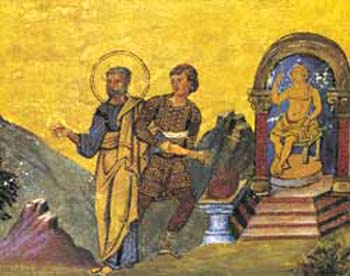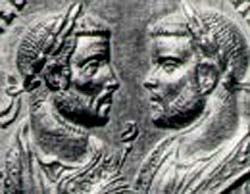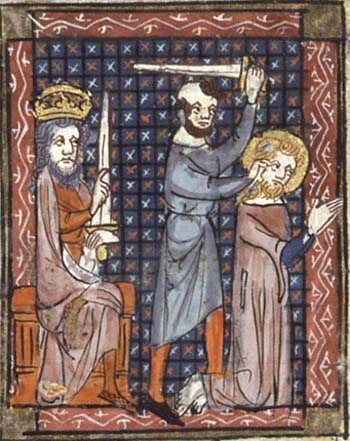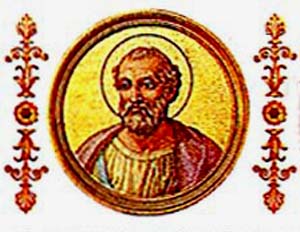 |
The Saint of the Day
Pope St. Marcellinus – April 26
Prof. Plinio Corrêa de Oliveira
Biographical selection:
Pope Marcellinus ruled the Church of Rome for nine years and four months. By order of Emperors Diocletian and Maximian he was taken prisoner and brought forward to offer sacrifice to the idols. At first he refused and was threatened with various kinds of torture, and for fear of the threatened suffering he put down two grains of incense in sacrifice to the gods. This gave great joy to the infidels but caused the faithful immense sadness.

Under Diocletian, a saint being dragged to the altar of Jupiter to burn incense before it - Menologe of Basil II
|
However, under a weak head, members rise up and make little of the threats of the princes, so the faithful came to the Pope and reproached him severely. He realized the gravity of his error and offered himself to be judged by a council of Bishops. The Bishops responded: “It is not possible for the Supreme Pontiff to be judged by anyone, but you yourself weigh your case in your own mind and pronounce your own judgment.”
The Pope, repentant, lamented his fault and deposed himself, but the whole gathering immediately re-elected him. When the Emperors heard of this, they had him arrested again. He absolutely refused to offer sacrifice to the idols, so they sentenced him to be beheaded. Then the persecution was renewed with such a fury that in one month 17,000 Christians were put to death.
When Marcellinus was about to be beheaded, he declared himself unworthy of Christian burial and excommunicated all who might presume to bury him. Thus his body lay above ground for 35 days. At the end of that time the Apostle Peter appeared to Marcellus, who had succeeded as Pope and said: “Brother Marcellus, why do you not bury me?” Marcellus replied: “Have you not yet been buried, my Lord?” Peter: “ I consider myself unburied as long as Marcellinus is unburied!” “But don’t you know, my Lord,” Marcellus asked, “that he laid a curse on anyone who buried him?” Peter: “Is it not written that he who humbles himself shall be exalted? You should have kept this in mind! Now go and bury him at my feet.” Marcellus went straightaway and carried out the orders laudably. (From the Golden Legend by Blessed Jacobus of Voragine)
Comments of Prof. Plinio:
There are many aspects worthy of attention in this narration of the Golden Legend.
First, it is interesting to see how human misery responds in face of fear. Pope Marcellinus had a horror to burn incense to the idols, so he only took two grains to burn, hoping to fool his own conscience. Actually, if a person were to burn one grain of incense or a whole handful, the act of idolatry is the same. The pagans understood that perfectly. The symbolic act had been made, and the Pope had apostatized. This was the reason for their joy.

Emperors Diocletian and Maximian
|
Second, the faithful Catholics also comprehended it perfectly. They came to reproach him and he realized the significance of his action. It is curious to see that until that moment, he had not faced the enormity of his own sin. It was necessary for the faithful to come and show him. Then, he repented and asked the Bishops to judge him. The repentance was good, but the request to be judged by the Bishops was another mistake of Pope Marcellinus. He was acting against Canon Law, since no one can judge the Pope. The faithful Bishops showed him that this was not possible. They reminded him that no one could judge him; rather, he should judge himself. He did so, and renounced his own position of Pope.
Third, the Bishops re-elected him. I don’t think that the Bishops acted correctly in re-electing him. A Pope who had apostatized from the Catholic Faith, becoming an idolater, should not be re-elected unless they had a divine premonition to do so, which is what Blessed Voragine insinuates in his narration above.
Fourth, reinvested as Pope, he was again brought before the idols to burn incense. This time he refused and died as a consequence of it. His final fidelity is the best refutation of his first villainous attitude. He died with complete repentance for his first sin.

The beheading of St. Marcellinus - Life of the Saints, Paris 14th c.
|
Fifth, at that time, when the Catholics died as martyrs in the arena or by some other torment, their bodies were left exposed for the crows to eat. Then, at night, the Catholics would go and take their bodies, bring them to the catacombs and give them a Catholic burial. Sometimes, a Mass would be said over the body – which is the highest honor anyone can expect – before it was given a dignified burial. Aware of the atrocious apostasy he had committed, St. Marcellinus wanted to prevent this honor for his body, so he excommunicated anyone who would try to bury him. He wanted to suffer this humiliation of his body as a punishment for his crime.
Sixth, we have the apparition of St. Peter. It is a beautiful story demonstrating how St. Peter shows solidarity with all the Popes through History. So, St. Peter asked: “Why don’t you bury me?” This is because any legitimate Pope is, in his mission, a continuation of St. Peter.
His command that revoked Marcellinus’ order did not violate Canon Law, since one Pope can revoke a positive law of another. Therefore, the excommunication set by St. Marcellinus was lifted by his successor. In an extreme act of mercy, St. Peter gave an order for that poor apostate and humble martyr to be buried near his own sepulcher.
Seventh; should we consider this report as true or false? The Golden Legend cannot be considered an indisputable historical source. It reports facts that are true along with some others that are not exact, where a bit of imagination enters, along with a great deal of good spirit and sense of the marvelous. To certify the credibility of the essential part of this account, I can tell you that analogous details regarding St. Marcellinus’ apostasy, repentance and martyrdom are also reported in the Roman Pontifical, which is a quite serious source.

St. Marcellinus
|
But, there is a lesson in this account of the Golden Legend that is valid forever. It is the glory given to God by a repentant sinner. There is no worse possible sin than apostasy. Even homicide in many ways is not as evil as apostasy. It is understandable, for Faith is the root of all virtues, and as such it is the most precious of all virtues. Hence, since St. Marcellinus sinned against Faith, he gravely denied his own mission. He had been chosen Pope to confirm his flock in the faith. When he apostatized, he denied his mission and led the faithful to do the same; he gave a great scandal, inviting the faithful to follow his very bad example. Nonetheless, after all this, he sincerely and deeply repented, so completely that St. Peter honored him by ordering that his body be buried near his own sepulcher.
Besides this moral lesson, there is also a historical one. It is to see how natural it was for the medieval man to accept that a Pope would sin. The Golden Legend was composed in the Middle Ages when no one would be surprised at the apostasy of a Pope. The Catholic sense was so strong that it did not go into shock at the possibility of a Pope apostatizing. I consider this a marvel of the Catholic sense. This book circulated for centuries reporting this story without any problem.
Today this Catholic sense is weakened. Should one merely raise the possibility of an apostate Pope, the objection rises: “But if he can apostatize, he is not infallible.” The answer is easy. Infallibility is either restricted to some special occasions or is linked to the constant teaching of the Church through the centuries. When Pope Marcellinus burned incense to the idols, neither of these meanings would apply to his action. Therefore, he apostatized, left the faith, and left the Church. It is possible for this to happen with a Pope like any other man. Papal infallibility was not tarnished by his crime.


  | | Prof. Plinio Corrêa de Oliveira | |
The Saint of the Day features highlights from the lives of saints based on comments made by the late Prof. Plinio Corrêa de Oliveira. Following the example of St. John Bosco who used to make similar talks for the boys of his College, each evening it was Prof. Plinio’s custom to make a short commentary on the lives of the next day’s saint in a meeting for youth in order to encourage them in the practice of virtue and love for the Catholic Church. TIA thought that its readers could profit from these valuable commentaries.
The texts of both the biographical data and the comments come from personal notes taken by Atila S. Guimarães from 1964 to 1995. Given the fact that the source is a personal notebook, it is possible that at times the biographic notes transcribed here will not rigorously follow the original text read by Prof. Plinio. The commentaries have also been adapted and translated for TIA’s site.
|
Saint of the Day | Home | Books | CDs | Search | Contact Us | Donate

© 2002- Tradition in Action, Inc. All Rights Reserved
|
 |

|